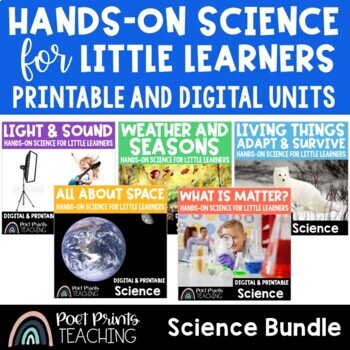Grade 1 Science BUNDLE
- Zip
- Google Apps™

What educators are saying
Products in this Bundle (5)
Description
Plan all of your Grade 1 Science units at the click of a button with this discounted bundle of 5 engaging science units for little learners! All 5 science units are perfect for grade 1 in British Columbia (they align to the BC Big Ideas!) and NGSS.
This bundle covers all of the Grade 1 BC Big Ideas for Science. In other provinces/territories/states the curriculum and content may be more appropriate for other grade levels.
Take back your time away from school with these high-quality resources that get the planning done for you! All resources included detailed lesson plans, teaching guides, and many print-and-go components.
Which resources are included in this Grade 1 Science Bundle?
- All About Matter - A simple introduction to the 3 states of matter, and hands-on lessons to describe materials by their properties.
- Weather and Seasons - A hands-on unit exploring daily and seasonal changes
- Light and Sound - Exploring the science of light and sound in a hands-on (and digital!) unit
- Living Things Survive - Exploring the structural features and survival of plants and animals.
- Space - An engaging look at objects in our solar system. How they move (orbit/rotate), how they help keep us warm, and how they are organized.
All units are both printable AND digital. Units include a complete printable PDF of teacher instructions and student work pages AND digital (Google Slides) versions of all student pages for use in virtual learning.
While these units are designed to be hands-on, most of the activities can be adapted for distance learning. Each unit includes DIGITAL, Google Slides student pages that can be uploaded into Google classroom for distance learning. If you are teaching remotely, I suggest teaching the lessons to your students via video (Zoom, Google meet, uploaded videos) and giving them a chance to work on any independent projects or assignments (in SMALL steps) at home. Or, try completing them together while on a video call! A full preview of all digital student pages is available as a video on each individual unit's product page.
What are teachers saying about the Grade 1 Science Units?
"This was a great resource! I loved how easy it was to prep. Best part was it kept my students engaged." ⭐⭐⭐⭐⭐ - Anamarie H. (Light and Sound Unit)
"Excellent resources for teaching Science standards!" ⭐⭐⭐⭐⭐ - Christine R. (Light and Sound Unit)
"Engaging activities! I appreciate quality resources when meeting the needs of my virtual students." ⭐⭐⭐⭐⭐ - Camping Kinders (Living Things Survive)
"My students used this resource in an ELA integrated theme with science lessons. This was directly aligned to the standards and was very engaging for the students. This resource helped to fill the gaps in our curriculum perfectly! The students LOVED it!" ⭐⭐⭐⭐⭐ - Tari S. (Solar System Unit)
Looking for more complete sets for the BC Big Ideas? I've got you covered!
Copyright © Poet Prints Teaching
All rights reserved by author.
Permission to copy for single classroom use only.





